TACE联合RFA与单纯RFA治疗肝细胞癌疗效与安全性比较的Meta分析
2017-10-23吕天石关海涛佟小强
尹 建,吕天石,关海涛,宋 莉,王 健,佟小强
(北京大学第一医院介入血管外科,北京 100034)
TACE联合RFA与单纯RFA治疗肝细胞癌疗效与安全性比较的Meta分析
尹 建,吕天石,关海涛,宋 莉,王 健,佟小强*
(北京大学第一医院介入血管外科,北京 100034)
目的采用Meta分析评价TACE联合射频消融(RFA)与单纯RFA治疗肝细胞癌(HCC)的疗效及安全性。方法检索2000年1月—2016年11月关于TACE联合RFA与单纯RFA治疗HCC的临床随机对照试验设计的中英文文献,提取纳入研究的信息并行Meta分析。结果共12篇文献入选本研究。Meta分析结果显示,TACE联合RFA组1年、3年总体生存率及1年、3年无瘤生存率均优于单纯RFA治疗组,差异有统计学意义(P均<0.05);两组间5年总体生存率差异无统计学意义(P=0.07)。对于肿瘤最大径<3 cm的HCC,TACE联合RFA组与单纯RFA组1年、3年总体生存率及1年、3年无瘤生存率差异均无统计学意义(P均>0.05)。两组间严重并发症发生率差异无统计学意义(P=0.82)。结论TACE联合RFA治疗HCC的近、中期疗效优于单纯RFA治疗,远期疗效无明显差异。
肝肿瘤;导管消融;经导管动脉化疗栓塞;Meta分析
原发性肝细胞癌(hepatocellular carcinoma, HCC)于恶性肿瘤病死率中居第3位[1-2]。多数患者确诊时已属中晚期,仅约30%的患者适合根治性手术治疗[3]。射频消融治疗(radiofrequency ablation, RFA)及TACE已成为中晚期肝癌的标准治疗方法,但2种方法均有局限性。近年来,有研究[4-5]报道将两者联合运用于肝癌治疗可使患者受益更大,但也有研究[6-7]发现单纯RFA治疗与TACE联合RFA治疗HCC患者的远期生存率并无显著差异。既往有学者对此争论并已进行Meta分析[8-9],但由于纳入文献数量相对较少或部分纳入文献[10]已被撤稿等原因,致其结论可信度受到影响。因此,本研究检索了国内外相关文献报道,对TACE联合RFA与单纯RFA治疗HCC患者的疗效与安全性进行Meta分析,旨在获得更可靠的结论。
1 资料与方法
1.1 文献检索 检索数据库为万方数据库、中国知网、EMBASE、Pubmed、Cochrane library,文献发表时间为2000年1月—2016年11月。中文检索词为“肝癌”、“介入治疗”、“化疗栓塞”、“ 射频消融”、“ 随机对照试验”;英文检索词为“TACE”、“RFA”、“ablation”、“randomized controlled trials”。
1.2 纳入标准 ①随机对照研究;②HCC患者年龄>18岁;③试验组及对照组包含“TACE+RFA组”及“单纯RFA组”;④研究结果中至少包含1年及以上“总体生存率(overall survival rates, OS)”或“无瘤生存率(recurrence-free survival rates, RS)”。
1.3 排除标准 ①总样本量小于30;②入组患者有肝功能衰竭、严重凝血功能障碍、心力衰竭等严重并发症;③入组患者无明确HCC的临床或病理诊断;④入组患者含门静脉癌栓、大量腹腔积液及肝外转移;⑤失访数超过研究总样本数的10%。
1.4 数据提取与质量评价 根据Cochrane使用手册中的偏倚风险评价表[11]对入选文献进行评价。由3名研究者根据纳入与排除标准独立进行文献筛选和资料提取,并交叉核对,有分歧时通过讨论解决或请第4名研究者仲裁。
1.5 统计学分析 采用Review Manager 5.0软件进行Meta分析,先做各试验结果异质性χ2检验,若检验结果I2<50%,P>0.1,提示纳入研究的各试验同质性较好,采用固定效应模型进行Meta分析;若I2>50%,P<0.1,提示纳入研究的各试验异质性具有统计学意义,则采用随机效应模型进行Meta分析。P<0.05为差异统计学意义。
2 结果
2.1 文献检索结果及基本特征 初步检索获得文献542篇,最终12篇[12-23]文献符合纳入标准,其中2篇文献为同一项研究(共11项研究)。文献筛选流程见图1。最终纳入12篇文献的基本特征见表1。

图1 文献筛选流程图
2.2 质量评价 12篇[12-23]文献根据Cochrane使用手册中的偏倚风险评价表[11]进行质量评价,结果显示所入选研究不存在较大偏倚风险(图2)。
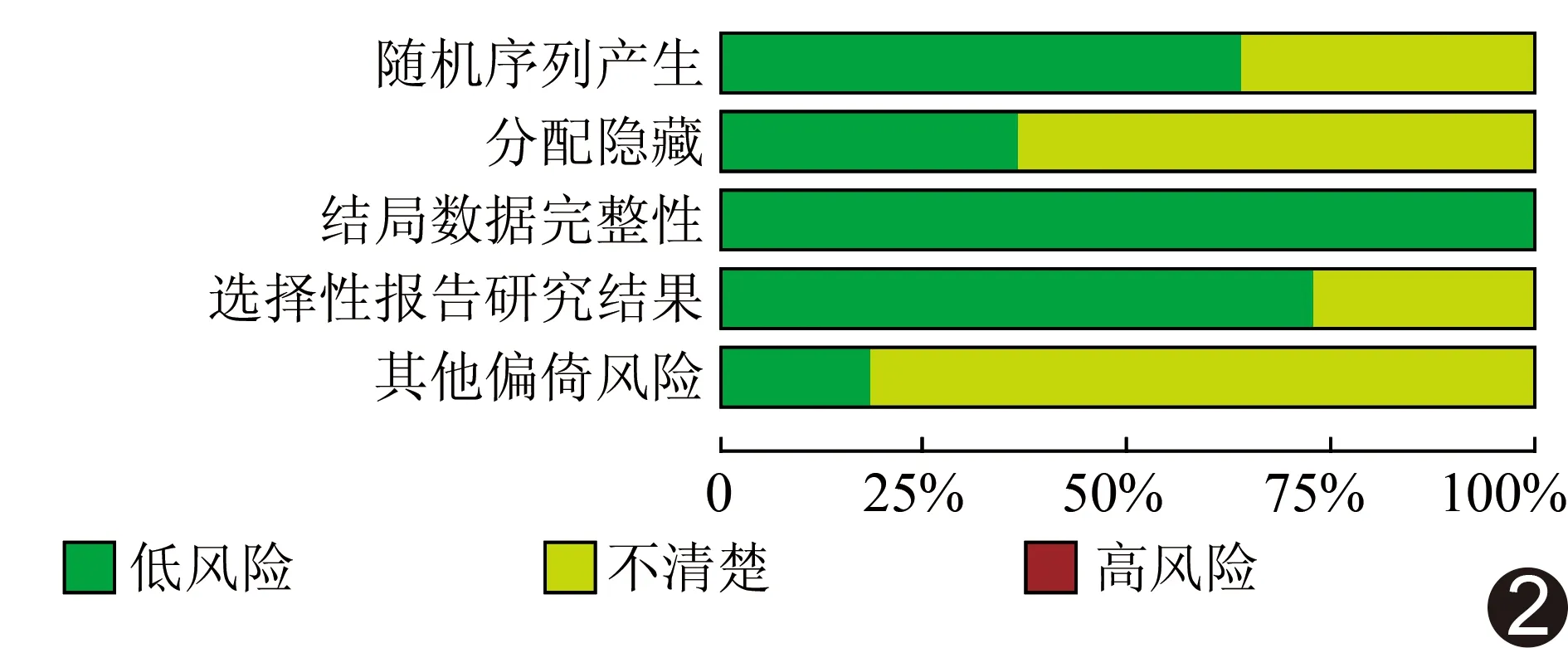
图2 纳入文献质量评价结果
2.3 Meta分析结果
2.3.1 OS 11项纳入研究中有10项研究(905例患者)报道了TACE联合RFA与单独RFA相比较的肝癌患者1、3、5年OS数据。1项研究[16]报道了2年OS及RS数据,故未入统计。其中有9项研究(829例患者)报道了1年OS数据,8项研究(793例患者)报道了3年OS数据,3项研究(270例患者)报道了5年OS数据(表2)。TACE联合RFA组的1、3、5年OS分别为80.29%(338/421)、71.28%(283/397)、54.81%(74/135);单纯RFA组1、3、5年OS分别为80.29%(348/408)、57.58%(228/396)、43.70%(59/135)。根据1、2、3、5年OS异质性检验结果,I2=0,P均>0.1,采用固定效应模型进行合并分析。Meta分析结果显示TACE联合RFA组的1年OS优于单独RFA组,OR=2.31,95%可信区间(confidence interval, CI)为(1.44,3.68),P=0.0005;3年OS亦优于单独RFA组,OR=1.90,95% CI为(1.40,2.57),P<0.0001;但2组5年OS差异无统计学意义,OR=1.57,95% CI为(0.97,2.56),P=0.07(表2、图3)。

表1 12篇纳入文献的基本特征
注:—:未提及;*:中位年龄

表2 纳入文献报道OS及RS结果
注:—:未提及;纳入的12篇文献中1篇(第一作者:王永中[16])未报道患者1、3、5年OS及RS数据(仅报道2年OS及RS数据),未入统计
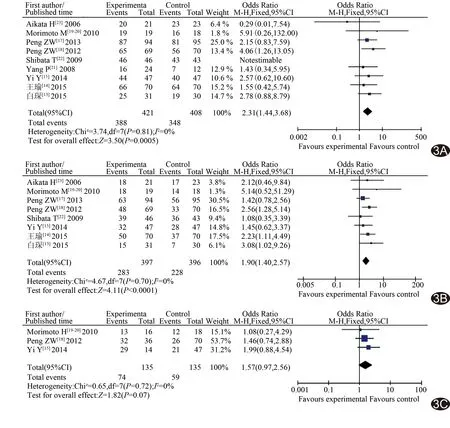
图3 TACE联合RFA与单纯RFA治疗患者OS的Meta分析 A.1年OS结果; B.3年OS结果; C.5年OS结果 (First author/Published time:第一作者/发表时间; Experimental:实验组,即TACE+RFA组;Control:对照组,即RFA组; Odds Ratio:比值比; Events:存活数; Total:总数; Weight:权重; M-H:M-H法; Fixed:固定效应模型; 95%CI:95%可信区间; Heterogeneity:异质性检验)
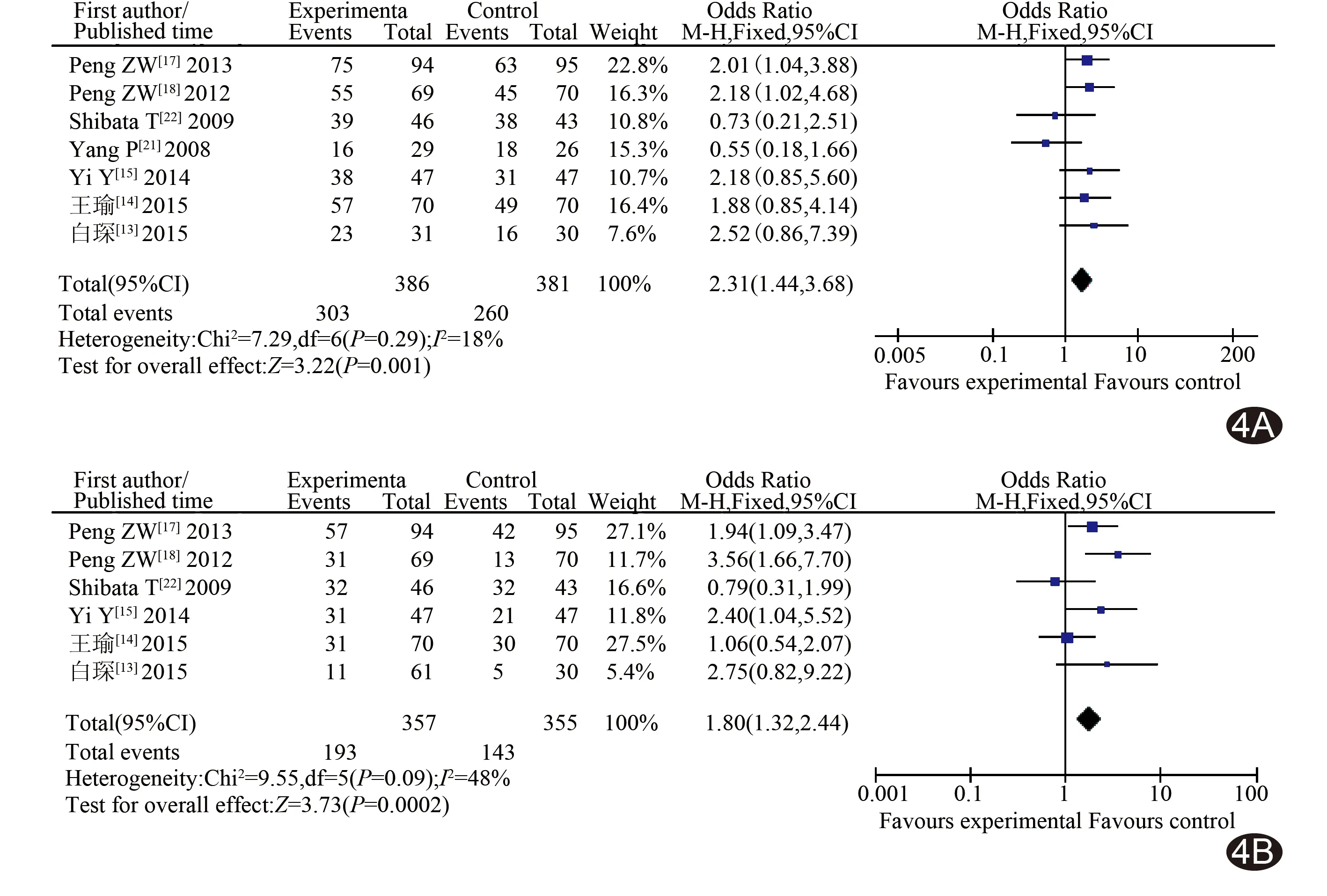
图4 TACE联合RFA与单纯RFA治疗患者RS的Meta分析 A.1年RS结果; B.3年RS结果 (First author/Published time:第一作者/发表时间; Experimental:实验组,即TACE+RFA组;Control:对照组,即RFA组; Odds Ratio:比值比; Events:存活数; Total:总数; Weight:权重; M-H:M-H法; Fixed:固定效应模型; 95%CI:95%可信区间; Heterogeneity:异质性检验)
2.3.2 RS 11项研究中有7项研究(767例患者)报道了RS数据。其中7项研究(767例患者)均报道了1年RS数据,6项研究(712例患者)报道了3年RS数据,仅有2项研究报道了5年RS数据(因研究数过少,未做Meta分析;见表2。TACE联合RFA组1年及3年RS分别为78.50%(303/386)及54.06%(193/357),单纯RFA组1年及3年RS分别为68.24%(260/381)及40.28%(143/355)。根据1年、3年RS的异质性检验结果,I2=0,P均>0.1,采用固定效应模型进行合并分析。Meta分析结果显示TACE联合RFA组1年RS优于单纯RFA组,OR=1.71,95%CI为(1.23,2.37),P=0.001;3年RS亦优于单纯RFA组,OR=1.80,95% CI为(1.32,2.44),P=0.0002(表2、图4)。
2.3.3 严重并发症 11项研究中共有9项研究(869例患者)报道了严重并发症情况,17例患者于术后发生了严重并发症,包括肝节段性坏死、胆道梗阻、消化道出血、中或大量腹腔积液、腹腔感染、小肠梗阻、持续性黄疸及肝功能衰竭。TACE联合RFA组及单纯RFA组严重并发症发生率分别为2.07%(9/435)及1.84%(8/434),根据异质性检验结果,I2=0,P均>0.1,采用固定效应模型进行合并分析。Meta分析结果显示2组严重并发症发生率比较无统计学意义,OR=1.12,95% CI(0.42,2.59),P=0.82(图5)。
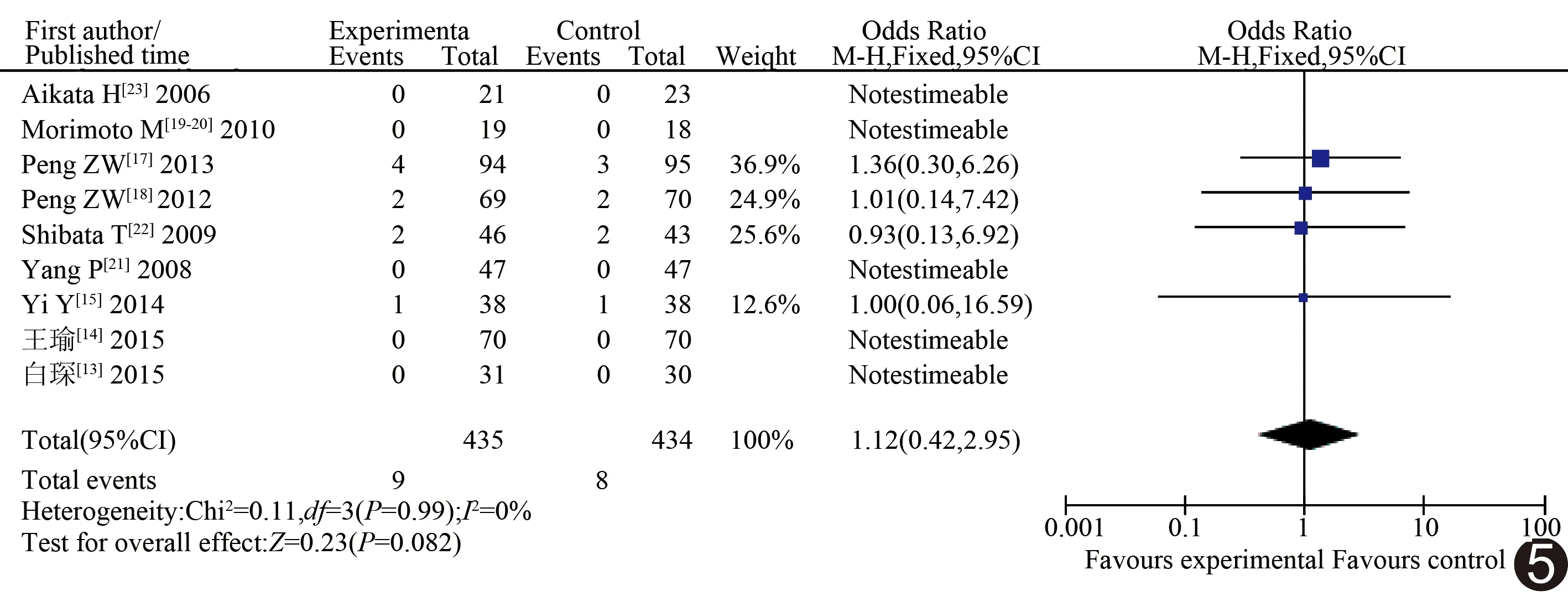
图5 TACE联合RFA与单纯RFA治疗患者严重并发症发生率Meta分析结果 (First author/Published time:第一作者/发表时间; Experimental:实验组,即TACE+RFA组;Control:对照组,即RFA组; Odds Ratio:比值比; Events:存活数; Total:总数; Weight:权重; M-H:M-H法; Fixed:固定效应模型; 95%CI:95%可信区间; Heterogeneity:异质性检验)
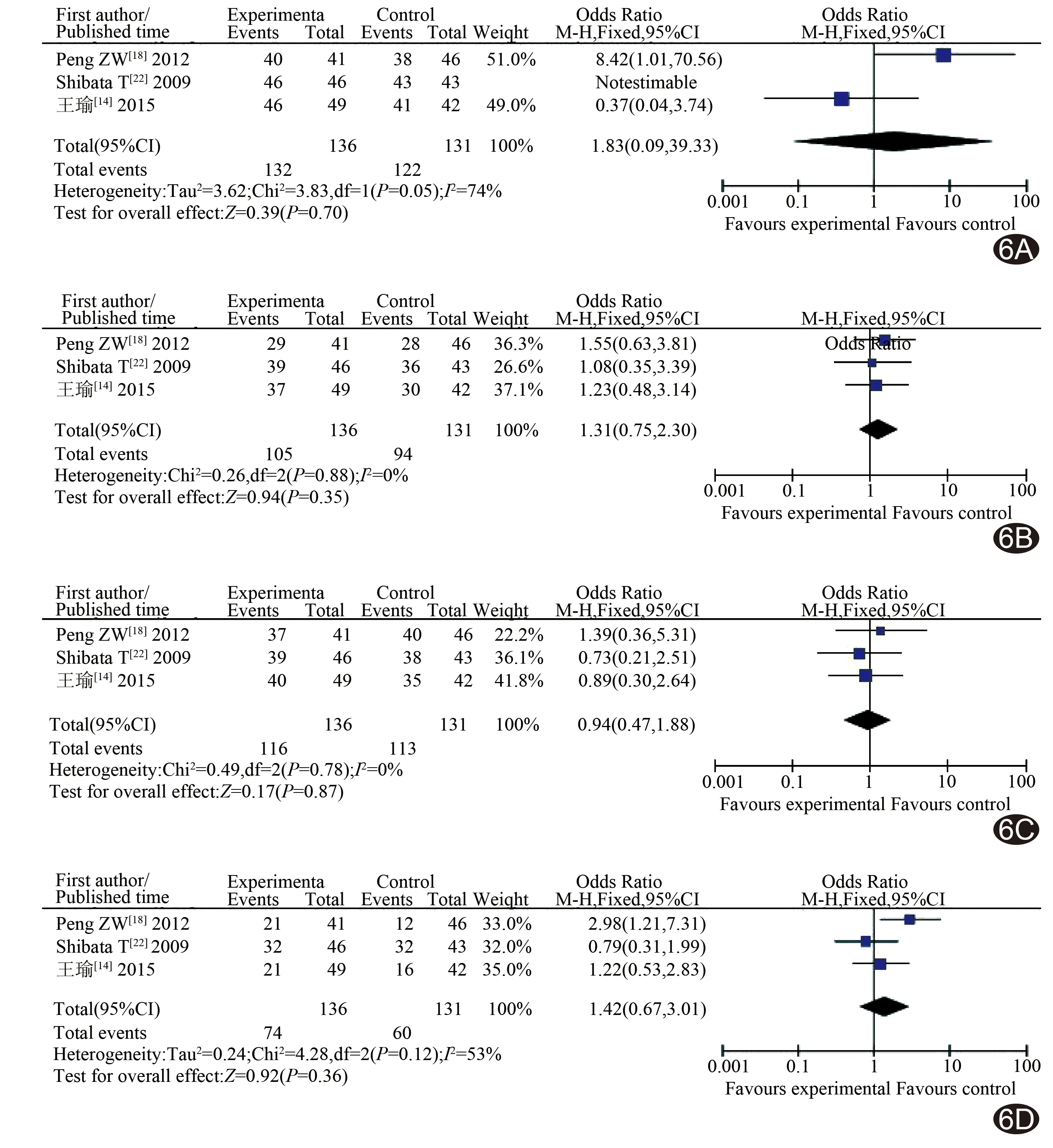
图6 肿瘤最大径<3 cm时的OS及RS的Meta分析结果 A.1年OS结果; B.3年OS结果; C.1年RS结果; D.3年RS结果 (First author/Published time:第一作者/发表时间; Experimental:实验组,即TACE+RFA组;Control:对照组,即RFA组; Odds Ratio:比值比; Events:存活数; Total:总数; Weight:权重; M-H:M-H法; Fixed:固定效应模型; 95%CI:95%可信区间; Heterogeneity:异质性检验)
2.3.4 肿瘤最大径<3 cm时的OS与RS比较 11项研究中有3项研究(267例患者)报道肿瘤最大径<3 cm患者的1年、3年的OS及RS数据。TACE联合RFA组1年、3年OS分别为97.06%(132/136)、77.21%(105/136),1年、3年RS分别为85.29%(116/136)、54.41%(74/136);单纯RFA组1年、3年OS分别为93.13%(122/131)、71.76%(94/131),1年、3年RS分别为86.26%(113/131)、45.80%(60/131)。根据异质性检验结果,1年OS及3年RS检验结果3项研究存在较大异质性(I2>50%,P均<0.1),故采用随机效应模型进行分析;3年OS及1年RS检验结果同质性较好(I2=0%,P均>0.1),故采用固定效应模型进行合并分析。Meta分析结果显示,2组1年、3年OS及RS差异均无统计学意义(P>0.05,图6)。
2.4 发表偏倚 以1年OS的Meta分析为例,漏斗图表明此Meta分析不存在明显的发表偏倚(图7)。
3 讨论
肝癌已成为致死率第3位的原发性恶性肿瘤[1-2],我国HCC新发病例与死亡人数均约占全球的50%[24]。RFA具有适应性广、创伤性小、安全性高及可重复性等优点,特别是对于最大径<3 cm的小肝癌患者,术后肿瘤完全坏死率可高达90%,其疗效可与手术切除相媲美[25];但有研究显示对于最大径3~5 cm的病灶,术后坏死率为60%;而肿瘤最大径>5 cm时,肿瘤完全坏死率仅为24%[26]。主要原因可能为丰富的血供导致热沉效应和肿瘤较大或位置特殊时RFA范围难以完全覆盖肿瘤的安全边缘等。为获得更好的疗效,近年来国内外学者提倡RFA或微波消融联合TACE的治疗方法。
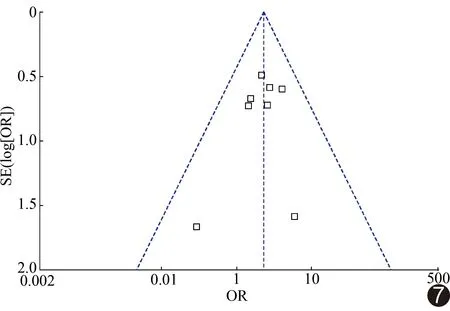
图7 HCC患者1年OS结果Meta分析漏斗图
目前TACE已成为巴塞罗那分期(BCLC)B期肝癌患者的标准治疗手段[27-28]。而TACE与RFA 2种方法联合运用可起到协同效果,其原因主要为TACE可通过栓塞肿瘤供血动脉及释放化疗药物对肿瘤进行灭活,同时可因有效减少了肿瘤血供致RFA时肿瘤的热沉效应降低,从而提高射频疗效。另TACE术后碘油的沉积可很好地勾勒出肿瘤边缘甚至显示出周围的卫星灶,有利于对肿瘤进行充分消融[29]。但TACE联合RFA疗法患者的预后是否较单独RFA治疗肝癌更好仍存争议[22,30-32]。
本研究对近年最新试验结果在内的国内外12篇文献,共11项RCT研究行Meta分析,结果表明TACE联合RFA组患者的3年OS和RS明显优于单纯RFA组,而2组的5年OS差异无统计学意义,这可能由于肝癌疾病本身的恶性生物学行为所致不良的预后及无论TACE或RFA自身对于肝癌疗效的局限性等多重因素造成。此外,当肿瘤最大径<3 cm时,2组的1年、3年总OS及RS差异无明显统计学意义,其原因可能为肿瘤较小时,射频范围较易对肿瘤及其安全边缘进行覆盖,从而行单纯RFA即可致肿瘤彻底灭活。
本研究进行Meta分析的不足:①入组标准不完善,入选研究存在潜在差异,如入组肝癌的病因、发病时间及既往史等,可增加Meta分析时组间的异质性;②仅部分研究报道了严重并发症的情况;③5年生存率及最大径<3 cm的肿瘤疗效的Meta分析数据不充足。
综上所述,TACE联合RFA治疗HCC患者的近、中期疗效优于单纯RFA治疗,而2种治疗方法的远期疗效无显著差异,今后还需更多高质量RCT结果及长期随访数据进一步证实。
[1] Trinchet JC. Hepatocellular carcinoma in 2014: Current situation and future prospects. Diagn Interv Imaging, 2014,95(7/8):705-708.
[2] Parkin DM, Bray F, Ferlay J, et al. Global cancer statistics, 2002. CA Cancer J Clin, 2005,55(2):74-108.
[3] Sangiovanni A, Del Ninno E, Fasani P, et al. Increased survival of cirrhotic patients with a hepatocellular carcinoma detected during surveillance. Gastroenterology, 2004,126(4):1005-1014.
[4] Min JH, Lee MW, Cha DI, et al. Radiofrequency ablation combined with chemoembolization for intermediate-sized (3-5 cm) hepatocellular carcinomas under dual guidance of biplane fluoroscopy and ultrasonography. Korean J Radiol, 2013,14(2):248-258.
[5] Kim JW, Shin SS, Kim JK, et al. Radiofrequency ablation combined with transcatheter arterial chemoembolization for the treatment of single hepatocellular carcinoma of 2 to 5 cm in diameter: Comparison with surgical resection. Korean J Radiol, 2013,14(4):626-635.
[6] Kim JW, Kim JH, Won HJ, et al. Hepatocellular carcinomas 2-3 cm in diameter: Transarterial chemoembolization plus radiofrequency ablation vs. radiofrequency ablation alone. Eur J Radiol, 2012,81(3):e189-e193.
[7] Tiong L, Maddern GJ. Systematic review and meta-analysis of survival and disease recurrence after radiofrequency ablation for hepatocellular carcinoma. Br J Surg, 2011,98(9):1210-1224.
[8] Ni JY, Liu SS, Xu LF, et al. Meta-analysis of radiofrequency ablation in combination with transarterial chemoembolization for hepatocellular carcinoma. World J Gastroenterol, 2013,19(24):3872-3882.
[9] Liu Z, Gao F, Yang G, et al. Combination of radiofrequency ablation with transarterial chemoembolization for hepatocellular carcinoma: An up-to-date meta-analysis. Tumor Biol, 2014,35(8):7407-7413.
[10] Cheng BQ, Jia CQ, Liu CT, et al. Chemoembolization combined with radiofrequency ablation for patients with hepatocellular carcinoma larger than 3 cm: A randomized controlled trial. JAMA, 2008,299(14):1669-1677.
[11] Higgins JP, Altman DG, Gøtzsche PC, et al. The cochrane collaboration's tool for assessing risk of bias in randomised trials. BMJ, 2011,343:d5928.
[12] Yew KC, Lin SM, Lin CC, et al. Switch-control radiofrequency ablation with and without chemoembolisation for hepatocellular carcinoma of 3.1—7 cm. Ann Acad Med Singapore, 2015,44(10):S449.
[13] 白琛,唐芳,骆伟,等.肝动脉化疗栓塞联合CT引导射频消融序贯治疗肝细胞癌的近远期疗效.中国医药,2015,10(8):1156-1160.
[14] 王瑜.射频消融后辅助肝动脉化疗栓塞治疗早期肝癌的前瞻性随机对照研究.重庆:第三军医大学,2015:18-27.
[15] Yi Y, Zhang Y, Wei Q, et al. Radiofrequency ablation or microwave ablation combined with transcatheter arterial chemoembolization in treatment of hepatocellular carcinoma by comparing with radiofrequency ablation alone. Chin J Cancer Res, 2014,26(1):112-118.
[16] 王永中,何洪涛,郭占军,等.射频消融术前行肝动脉化疗栓塞治疗老年肝癌的疗效.中国老年学杂志,2014,34(23):6603-6605.
[17] Peng ZW, Zhang YJ, Chen MS, et al. Radiofrequency ablation with or without transcatheter arterial chemoembolization in the treatment of hepatocellular carcinoma: A prospective randomized trial. J Clin Oncol, 2013,31(4):426-432.
[18] Peng ZW, Zhang YJ, Liang HH, et al. Recurrent hepatocellular carcinoma treated with sequential transcatheter arterial chemoembolization and RF ablation versus RF ablation alone: A prospective randomized trial. Radiology, 2012,262(2):689-700.
[19] Morimoto M, Numata K, Kondou M, et al. Midterm outcomes in patients with intermediate-sized hepatocellular carcinoma: A randomized controlled trial for determining the efficacy of radiofrequency ablation combined with transcatheter arterial chemoembolization. Cancer, 2010,116(23):5452-5460.
[20] Morimoto M, Numata K, Kondou M, et al. Long-term outcome in patients with intermediate-sized hepatocellular carcinoma: A randomized controlled trial to determine the efficacy of radiofrequency ablation combined with transcatheter arterial chemoembolization: 2144. Hepatology, 2011,54(4):1366A-1367A.
[21] Yang P, Liang M, Zhang Y, et al. Clinical application of a combination therapy of lentinan, multi-electrode RFA and TACE in HCC. Adv Ther, 2008,25(8):787-794.
[22] Shibata T, Shibata T, Maetani Y, et al. Radiofrequency ablation for small hepatocellular carcinoma: Prospective comparison of internally cooled electrode and expandable electrode. Radiology, 2006,238(1):346-353.
[23] Aikata H, Shirakawa H, Takaki S, et al. Radiofrequency ablation combined with transcatheter arterial chemoembolization for small hepatocellularcarcinoma. Hepatology, 2006,44(4S1):494a.
[24] Torre LA, Bray F, Siegel RL, et al. Global cancer statistics, 2012. CA Cancer J Clin, 2015,65(2):87-108.
[25] Chen MS, Li JQ, Zheng Y, et al. A prospective randomized trial comparing percutaneous local ablative therapy and partial hepatectomy for small hepatocellular carcinoma. Ann Surg, 2006,243(3):321-328.
[26] Livraghi T, Goldberg SN, Lazzaroni S, et al. Hepatocellular carcinoma: Radio-frequency ablation of medium and large lesions. Radiology, 2000,214(3):761-768.
[27] Bruix J, Sherman M. Management of hepatocellular carcinoma: An update. Hepatology, 2011,53(3):1020-1022.
[28] Forner A, Llovet JM, Bruix J. Hepatocellular carcinoma. Lancet, 2012,379(9822):1245-1255.
[29] Yamakado K, Nakatsuka A, Takaki H, et al. Subphrenic versus nonsubphrenic hepatocellular carcinoma: Combined therapy with chemoembolization and radiofrequency ablation. AJR Am J Roentgenol, 2010,194(2):530-535.
[30] Song MJ, Bae SH, Lee JS, et al. Combination transarterial chemoembolization and radiofrequency ablation therapy for early hepatocellular carcinoma. Korean J Intern Med, 2016,31(2):242-252.
[31] 岳军艳,李玉侠,王清华,等.TACE联合RFA与TACE联合冷循环微波刀治疗原发性肝癌的疗效比较.中国介入影像与治疗学,2010,7(6):656-659.
[32] 申太忠,宋莉,杨敏,等. TACE联合RFA治疗原发性肝细胞癌预后多因素分析.中国介入影像与治疗学,2012,9(5):322-326
文章题名要求
▲题名应以简明、确切的词语反映文章中最重要的特定内容,要符合编制题录、索引和检索的有关原则,并有助于选定主题词。
▲中文题名一般不宜超过20个字,必要时可加副题名。
▲英文题名应与中文题名含义一致。
▲题名应避免使用非公知公用的缩写词、字符、代号,尽量不出现数学公式和化学式。
EfficacyandsafetyofradiofrequencyablationcombinedwithorwithoutTACEforhepatocellularcarcinomasMeta-analysis
YINJian,LYUTianshi,GUANHaitao,SONGLi,WANGJian,TONGXiaoqiang*
(DepartmentofInterventionalRadiologyandVascularSurgery,PekingUniversityFirstHospital,Beijing100034,China)
ObjectiveTo investigate the effectiveness and safety of TACE combined with radiofrequency ablation (RFA) and simple RFA in the treatment of hepatocellular carcinoma (HCC) with Meta-analysis.MethodsThe randomized controlled trials comparing of TACE combined with RFA and simple RFA in the treatment of HCC from January 2000 to November 2016 in Chinese and English literatures were included.ResultsA total of 12 articles were enrolled in this study. Meta-analyses showed that the 1-year, 3-year overall survival rate and 1-year, 3-year recurrence-free survival rate of TACE combined with RFA group were better than those of simple RFA group (allP<0.05). And there was no significant difference between TACE combined with RFA group and simple RFA group in 5-year overall survival rate (P=0.07). There was no significant difference of the 1-year, 3-year overall survival and 1-year and 3-year recurrence-free survival rate between TACE combined with RFA group and simple RFA group for tumor with maximum diameter <3 cm in HCC (allP>0.05). There was no significant difference in the incidence of serious complication in both two groups (P=0.82).ConclusionThe short-term and mid-term efficacy in the treatment of HCC using TACE combined with RFA is better than those using simple RFA, while the long-term efficacy of two kinds of therapy have no significant differences.
Liver neoplasms; Catheter ablation; Transcatheter arterial chemoembolization; Meta-analysis
R735.7
A
1672-8475(2017)10-0606-07
尹建(1987—),男,北京人,在读硕士,医师。研究方向:介入放射学。E-mail: 18600262726@163.com
佟小强,北京大学第一医院介入血管外科,100034。E-mail: txq_1125@163.com
2017-02-17
2017-08-15
10.13929/j.1672-8475.201702019
